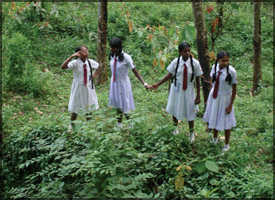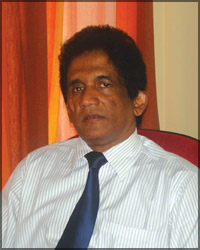|
Pilot project on Disaster Risk Reduction in schools:
Right step towards disaster risk reduction
by Indeewara Thilakarathne and Ranga Chandrarathne

|

Major General
Gamini Hettiarachchi
Director General of the
Disaster Management Centre |

Zihan Zarouk,
Field Coordinator UNDP
Disaster Risk Management Programme |
It is a fact that children are among the vulnerable segments in a
disaster and preparedness for a disaster is vital in disaster risk
reduction. This project was conducted under the patronage of the
Secretary of the Ministry of Disaster Management and Human Rights Prof.
Rajiva Wijesinha and the Director General of the Disaster Management
Centre Major General Gamini Hettiarachchi with the support of zonal
education officers.
The pilot project on Disaster Risk Reduction in schools launched by
the Disaster Management Centre is aimed at achieving the goals of a safe
nation, according to the Road Map for Disaster Management in Sri Lanka.
The education system has been identified as a strategic intervention
area that has the strong potential to create a positive impact on
society. If the children are aware of the causes and consequences of
disasters, it would eventually lead to raise public awareness on the
matter.
The project was conceptualized and implemented with financial
assistance from the United Nations Office for Coordination of
Humanitarian Affairs (UN OCHA) from July 2007.
Goals
The overall goal of the project is to integrate school preparedness
and response strategies with those of community and institutional
preparedness and response plans drawn up by vulnerable communities. The
Disaster Management Centre (DMC) was selected as the main government
partner to implement the project activities as it was the institution
mandated by the Government of Sri Lanka to coordinate all disaster
management-related activities. The German Technical Corporation (GTZ)
was another civil society organization working in collaboration with the
DMC on school-level disaster risk reduction and preparedness activities.
This pilot project focuses on three schools in districts which are
vulnerable to different socio-natural hazards commonly occurring in Sri
Lanka. Initially, 48 schools were identified by the District Disaster
Management Coordinators in collaboration with the Zonal Education
Directors of the Department of Education in 16 districts.
The schools were selected on the basis of their vulnerability to
major hazards (i.e. floods, landslides, tsunamis, lightning, cyclones,
drought, epidemics, etc.) in Sri Lanka, located in areas where Grama
Niladari-level Disaster Preparedness and Response Plans have been
developed and schools with active School Development Societies and
school administrations which are willing to implement the pilot project
activities.
Among the objectives of the project were to develop a teachers’ guide
to build the capacity of teachers in DRR, to train schoolchildren in
first aid and promote it as an essential life skill among school
children and School Development Society members to train children in
selected schools to serve as animators for the community in monitoring
rainfall data and in providing early warning information to Village
Disaster Management Committees and to support teachers and students in
developing proposals for improving safety measures in their schools and
provide funding for small-scale vulnerability reduction and mitigation
activities.
For the pilot project Akiriyankumbura Maha Vidyalaya in the Ridi
Maliyadda DS Division Badulla District and Koslanda Madya Maha Vidyalaya
have been selected. The children of Akiriyankumbura Maha Vidyalaya have
to undergo many hardships including sever droughts and wild fires. As
the main occupation in the area is cultivation of paddy and chena
cultivation, during the dry season people find it hard to get water for
drinking, domestic and agricultural purposes.
As the initial step a disaster management awareness programme for 50
students was conducted by the District Disaster Management Coordination
Unit (DDMCU) in collaboration with United Nations Development Programme
(UNDP) with the technical support of the Forest Department and National
Water Supply and Drainage Board. As a long term measure the school
Disaster Management Circle was formed and the school decided to develop
a model green house which would serve as a model site for school
children to learn agricultural innovation with special emphasis on
drought resistant varieti es of crops.
Schools submitted model disaster mitigation projects. Considering the
overall submissions, most of the projects, were found to be linked with
learning components for students while some were focused on structural
mitigation. Developing a model lightning protection system, using
children as animators to prevent frost fire in the village, fixing a
‘live fence’ to prevent elephant attacks of the school, construction of
a staircase for emergency evacuation, water purification system and rain
water harvesting to prevent fluorosis among children were some of the
mitigation projects identified by the other selected schools.
Activities initiated under the project include formation of School
Disaster Management Circles, Strengthening the Circle with capacity
development United Nation Development Programme (UNDP) in affiliation
with the Disaster Management Centre (DMC) initiated the School Disaster
Management Project in 48 schools in 16 districts including conflict
affected Ampara, Batticaloa, Trincomalee and Jaffna District with the
financial support of the United Nations Office for the Coordination of
Humanitarian Affairs (UNOCHA). |

